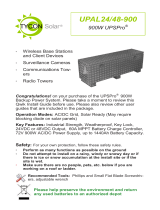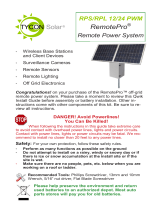Page is loading ...

UPS-PL-120
UPSPro®
Outdoor UPS System
▫ Wireless Base Stations
and Client Devices
▫ Surveillance Cameras
▫ Mission Critical Backup
Power
▫ Remote Sensors
Congratulations! on your purchase of the UPSPro®Outdoor
UPS backup power system. Please take a moment to review this
Qwik Install Guide before assembly or battery installation.
DANGER! Avoid Powerlines!
You Can Be Killed!
When following the instructions in this guide take extreme care
to avoid contact with overhead power lines, lights and power circuits.
Contact with power lines, lights or power circuits may be fatal. We rec-
ommend to install no closer than 20 feet to any power lines.
Safety: For your own protection, follow these safety rules.
▫ Perform as many functions as possible on the ground
▫ Do not attempt to install on a rainy, windy or snowy day or if
there is ice or snow accumulation at the install site or if the
site is wet.
▫ Make sure there are no people, pets, etc. below when you are
working on a roof or ladder.
Recommended Tools: Phillips Screwdriver, Flat Blade Screw-
driver, 3/8” Deep Socket for enclosure bolt
Please help preserve the environment and return
used batteries to an authorized depot

2
Qwik Install
STEP 1: The UPSPro® is Solar Ready™ so a solar panel can be added
at any time to provide supplemental or full time power. Solar panel will
be connected to PV input (Solar Panel Symbol) in parallel with AC Pow-
er supply. Solar panels must have blocking diodes which is the stand-
ard for most solar panels.
STEP 2: Install 2 or 4 batteries in a 12V or 24V configuration, depend-
ing on which system you purchased. Connect wires first to the Solar
Controller battery input (Battery Symbol), then connect to batteries. Ob-
serve proper polarity. Red wire is always V+.
STEP 3: Connect the 120W 12V or 24V battery charger to the Solar
Controller PV input (Solar Panel Symbol). Make sure to observe proper
polarity. Red wire is always V+. The controller has a pluggable 2 wire
AC cord. You can cut this cord to hardwire into the mains. You can also
mount conduit to the enclosure if local codes require it. During opera-
tion the charger will be very warm to the touch. This is normal.
STEP 4: Mount the solar charge controller to the metal plate with the
Velcro tape provided.
STEP 5: Mount any customer electronics to the inside of the door using
Velcro tape with 3M VHB adhesive. There is about 2.5” of depth availa-
ble between the cover and the lower battery area. Connect any loads to
the Solar Controller LOAD output. (Light Bulb Symbol). Press red but-
ton to turn on/off the LOAD output.
Note: There are multiple rubber feedthrough in the bottom of the enclo-
sure. Slice a small “+” in the rubber using a blade and feed the wires
through the opening, stretching the rubber in the process.
STEP 6: Test the enclosure operation before installing outside. The
solar controller display shows battery voltage, charging current, load
current and temperature.
STEP 7: Install the enclosure to a pole using stainless steel hose
clamps provided or to a wall using lag bolts. Prior to install you may
want to temporarily remove the batteries so install weight is less.
STEP 8: Make sure lid gasket is clean and free from any particles, then
carefully close the cover, making sure that wires are clear of the seam
and hinge area. The cover snaps into place. There is one center 3/8”
security bolt that can be used to secure the cover.
NOTE: If you have any unconnected battery connectors on battery
cable after installation, make sure they are wrapped with electrical
tape so that there is no chance of shorting the connector to any
metal. You can also remove the extra cable/connector permanently
by cutting the cable at the existing battery connection.

3
4 Battery 12V Layout 2 Battery 24V Layout

4

5
SPECIFICATIONS Subject to change without notice
Battery Voltage (DC) 12V or 24V
Load Output Voltage (DC) 11-15VDC / 22-29VDC
Suggested Max Load 100W
AC Input Voltage 120/240VAC 50/60Hz 2.5A Max
Battery Charge Voltage 14.4V / 28.8V
Battery Charge Current 8.3A / 4.35A
Battery Charge Capacity 120W
Capacity 9Ah to 36Ah
Battery Type Valve Regulated Sealed Lead Ac-
id / Absorbent Glass Mat (AGM)
Battery Life 5 Years
Controller Type 20A PWM with status display and
load control
Overcharge Protection 14.4V / 28.6V
Over-discharge protection 11V / 22V
Over-discharge recovery voltage 12.5V / 25V
Controller Self Consumption <0.3W
Enclosure Type Polycarbonate
Enclosure External Size 17.5 x 12.5 x 6”
(445 x 318x 152mm)
Enclosure Internal Size 14 x 10 x 5”
(356 x 254 x 127mm)
Operating Temperature -30°C to +60°C
System Weight (without batteries) 6lb (2.7kg)
Battery Weight (each) 2.5kg (5.5lb)

6
TECH CORNER
1.CONTROLLER: The controller turns off power to the load at 11V
(22V if 24V array) and reconnects when the battery reaches 12.5V (25V
if 24V array). This protects battery from over-discharge and increases
battery life and performance.
2. CAPACITY: With a typical AP running 4W average. A single 12V
9Ah battery should be able to provide backup power for up to 24 hours
at room temperature. For cold temperatures the capacity is reduced by
20-30%.
3. VENTING: The enclosure is vented thru the wire feedthrus in the bot-
tom of the enclosure. Don’t make these airtight.
4. DUAL INPUTS: The UPS-PL-120 can be used with AC Power alone
or Solar Power alone or a combination of both.
5. SOLAR PANEL: The controller used in the UPS-PL can handle a

7
maximum panel size of 160W. Do not exceed 10A into the solar panel
input of the solar controller.
6. BATTERY HOOKUP: Always connect the battery first and discon-
nect the battery last. The controller should not be run without a battery
connected.
7. BATTERY MAINTENANCE: The batteries used in the UPSPro sys-
tems don’t require any maintenance. They should last up to 5 years in
normal use. Note: Never store batteries for any length of time in a
discharged state or it will kill the battery.
8. BATTERY OVERDISCHARGE: We highly recommend hooking all
equipment loads to the controller load output. This output will discon-
nect the load if the battery voltage is too low and this will protect the
battery from over-discharge. If batteries get completely discharged be-
cause the equipment was connected directly to the battery, you will re-
duce the battery life.
9. LOAD OUTPUT: The LOAD output on the Solar Charge Controller is
unregulated. What that means is the voltage output follows the battery
voltage. This is typically 11-15V for a 12V system and 22-29V for a 24V
system. It is up to the user to make sure the connected load is compati-
ble with these voltages. A voltage regulator can be added to provide
regulated output voltages.
Limited Warranty
The UPSPro® products are supplied with a limited 36 month warranty
which covers material and workmanship defects. This warranty does
not cover the following:
▫ Parts requiring replacement due to improper installation, misuse, poor site
conditions, faulty power, etc.
▫ Lightning or weather damage.
▫ Physical damage to the external & internal parts.
▫ Products that have been opened, altered, or defaced.
▫ Water damage for units that were not mounted according to user manual.
▫ Usage other than in accordance with instructions and the normal intended
use.
NOTES

8
8000069 Rev 1 UPS-PL-120 UPSPro® Qwik Install Guide
/










